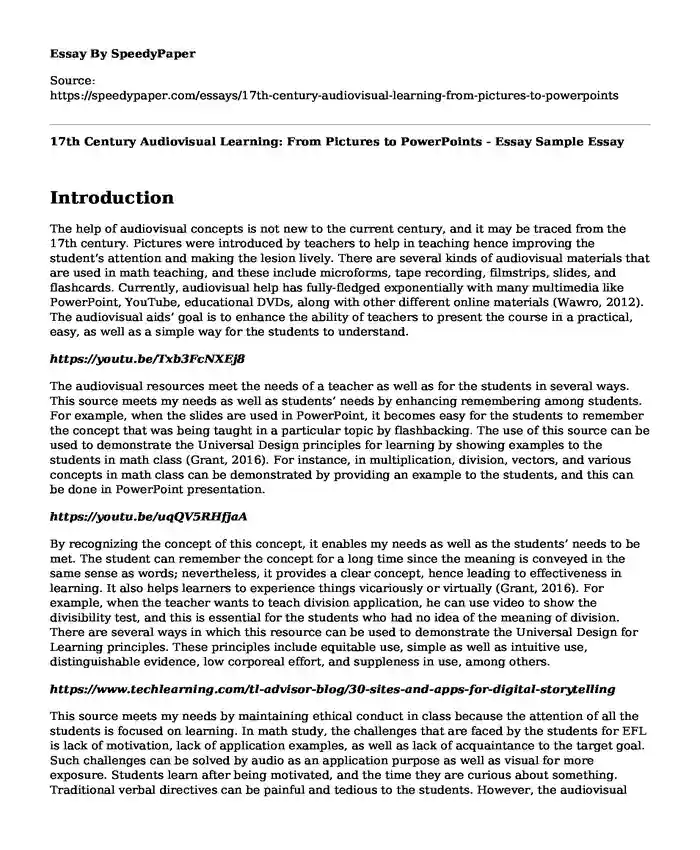Introduction
The help of audiovisual concepts is not new to the current century, and it may be traced from the 17th century. Pictures were introduced by teachers to help in teaching hence improving the student’s attention and making the lesion lively. There are several kinds of audiovisual materials that are used in math teaching, and these include microforms, tape recording, filmstrips, slides, and flashcards. Currently, audiovisual help has fully-fledged exponentially with many multimedia like PowerPoint, YouTube, educational DVDs, along with other different online materials (Wawro, 2012). The audiovisual aids’ goal is to enhance the ability of teachers to present the course in a practical, easy, as well as a simple way for the students to understand.
https://youtu.be/Txb3FcNXEj8
The audiovisual resources meet the needs of a teacher as well as for the students in several ways. This source meets my needs as well as students’ needs by enhancing remembering among students. For example, when the slides are used in PowerPoint, it becomes easy for the students to remember the concept that was being taught in a particular topic by flashbacking. The use of this source can be used to demonstrate the Universal Design principles for learning by showing examples to the students in math class (Grant, 2016). For instance, in multiplication, division, vectors, and various concepts in math class can be demonstrated by providing an example to the students, and this can be done in PowerPoint presentation.
https://youtu.be/uqQV5RHfjaA
By recognizing the concept of this concept, it enables my needs as well as the students’ needs to be met. The student can remember the concept for a long time since the meaning is conveyed in the same sense as words; nevertheless, it provides a clear concept, hence leading to effectiveness in learning. It also helps learners to experience things vicariously or virtually (Grant, 2016). For example, when the teacher wants to teach division application, he can use video to show the divisibility test, and this is essential for the students who had no idea of the meaning of division. There are several ways in which this resource can be used to demonstrate the Universal Design for Learning principles. These principles include equitable use, simple as well as intuitive use, distinguishable evidence, low corporeal effort, and suppleness in use, among others.
https://www.techlearning.com/tl-advisor-blog/30-sites-and-apps-for-digital-storytelling
This source meets my needs by maintaining ethical conduct in class because the attention of all the students is focused on learning. In math study, the challenges that are faced by the students for EFL is lack of motivation, lack of application examples, as well as lack of acquaintance to the target goal. Such challenges can be solved by audio as an application purpose as well as visual for more exposure. Students learn after being motivated, and the time they are curious about something. Traditional verbal directives can be painful and tedious to the students. However, the audiovisual support use offers an intrinsic motivation to learners via peaking their inquisitiveness along with stimulating the learners’ interest in math subjects. This source demonstrates principles by granting the students time to do the practice on their own and try to apply the concepts. In most cases, this becomes the best way for a demonstration since the students will be able to understand the meaning of various applications.
Conclusion
In conclusion, audiovisual resources are essential for teaching. They make it possible for the needs of both the teacher and the students to be met without much struggle. They help the students to remember various examples that were used by the teacher during various lessons hence becoming possible to apply the concept. Schools should change from the traditional way of teaching and concentrate on digital methods to improve the student’s understanding.
References
Grant, N. (2016). Digital Storytelling: A Method for Engaging Students and Increasing Cultural Competency (pp. 22-26). Retrieved from https://www.semanticscholar.org/paper/Digital-Storytelling%3A-A-Method-for-Engaging-and-Grant-Bolin/013c18eeace5932c7a80e84d7911d745d6008165
Wawro, L. (2012). Digital Storytelling More than the Sum of Its Parts (pp. 50-52). Retrieved from https://search.proquest.com/openview/adef3098b092db980d84ea633d1ba8d3/1?pq-origsite=gscholar&cbl=52910
Cite this page
17th Century Audiovisual Learning: From Pictures to PowerPoints - Essay Sample. (2023, Oct 29). Retrieved from https://speedypaper.net/essays/17th-century-audiovisual-learning-from-pictures-to-powerpoints
Request Removal
If you are the original author of this essay and no longer wish to have it published on the SpeedyPaper website, please click below to request its removal:
- Scholarship Essay Example
- Personal Essay Example for Apply Graduate School
- Free Essay - Life at Small Scale: The Behavior of Microbes
- Free Essay on Coaching and Counselling
- Essay Sample on Investigating Various Aspects of Plant Physiology
- Essay Sample on Case Study: Social Media
- Free Essay. Curriculum Activity Cognitive and Language Development
Popular categories





